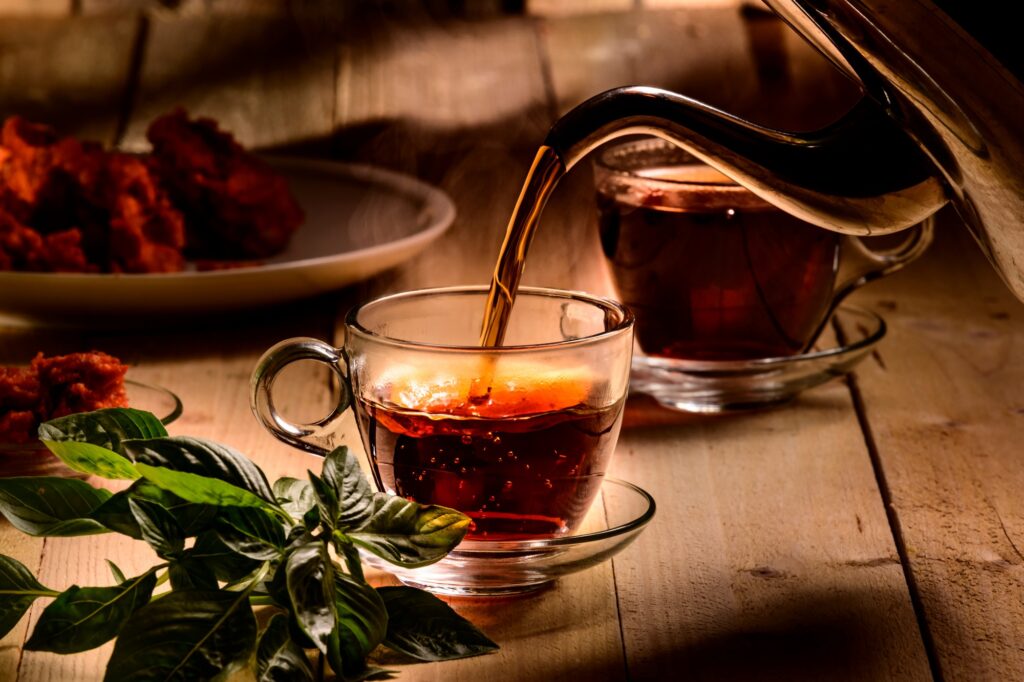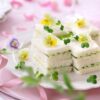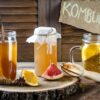
Black tea, a beloved beverage enjoyed by millions around the world, is a true delight for the senses. Its rich, robust flavor and invigorating aroma have captivated tea enthusiasts for centuries. This remarkable beverage is not merely a drink; it is a cultural phenomenon, steeped in tradition and intricately woven into the fabric of societies across the globe.
From the lush tea gardens of Assam to the rolling hills of Darjeeling, the journey of black tea is a fascinating tale of cultivation, processing, and artistry. Each sip holds the promise of a unique experience, transporting the drinker to a world of flavor and history.
The history and origins of black tea
The story of black tea is a captivating one, tracing its roots back to ancient China. It is believed that the discovery of tea dates back to the 3rd century AD, when a few stray leaves from a Camellia sinensis plant accidentally fell into a pot of boiling water, creating the first tea infusion.
As tea cultivation and consumption spread throughout China and eventually to other parts of Asia, different processing techniques emerged, giving rise to various tea types. Black tea, in particular, is the result of a unique oxidation process that transforms the fresh tea leaves into a rich, dark brew.
The origins of black tea can be traced back to the Fujian province of China, where the technique of fully oxidizing tea leaves was first developed. From there, the production of black tea spread to other regions, each putting its own unique spin on the process.
The different types of black tea
Black tea is a diverse category, with numerous varieties and blends that cater to different taste preferences and cultural traditions. Some of the most renowned types of black tea include:
- Assam Black Tea: Hailing from the lush tea gardens of Assam, India, this robust and full-bodied tea is known for its rich, malty flavor and bright, reddish-brown color.
- Darjeeling Black Tea: Grown in the foothills of the Himalayas, Darjeeling black tea is celebrated for its delicate, floral aroma and distinct muscatel notes.
- Ceylon Black Tea: Originating from Sri Lanka (formerly Ceylon), this tea is renowned for its bright, brisk flavor and vibrant golden-orange liquor.
- Keemun Black Tea: A prized Chinese black tea from the Anhui province, Keemun is renowned for its smooth, slightly smoky taste and delicate floral notes.
- Lapsang Souchong: Another Chinese black tea, Lapsang Souchong is renowned for its distinctive smoky aroma and flavor, achieved through a unique drying process over pine smoke.
These are just a few examples of the vast array of black tea varieties available, each with its unique character and flavor profile.
The production process of black tea
The journey of black tea from the garden to the cup is a meticulous and intricate process, involving several stages of careful handling and processing. The production process typically involves the following steps:
- Plucking: The first step in the production of black tea is the plucking of the tender tea leaves and buds from the Camellia sinensis plant. This is often done by skilled tea pickers, who carefully select only the finest leaves and buds.
- Withering: Once plucked, the tea leaves are spread out and allowed to wither or wilt, which helps to remove excess moisture and initiate the oxidation process.
- Rolling: The withered leaves are then rolled or twisted, which helps to break down the cellular structure and release the enzymes responsible for oxidation.
- Oxidation: This crucial step is what distinguishes black tea from other tea types. The rolled leaves are exposed to air, allowing the enzymes to interact with oxygen, resulting in the characteristic dark color and robust flavor of black tea.
- Firing or Drying: After the desired level of oxidation is achieved, the tea leaves are heated or fired to stop the oxidation process and remove any remaining moisture.
- Sorting and Grading: The dried tea leaves are then sorted and graded based on their size, shape, and quality, ensuring consistency and quality control.
- Packaging: Finally, the graded tea is packaged for distribution and sale, often in airtight containers to preserve its freshness and flavor.
Throughout this intricate process, skilled tea makers carefully monitor and adjust the various steps to achieve the desired flavor profile and quality of the final black tea product.
The health benefits of black tea
Beyond its captivating flavor and aroma, black tea offers a host of potential health benefits that have been explored by numerous scientific studies. Here are some of the notable advantages associated with consuming black tea:
- Rich in Antioxidants: Black tea is a rich source of powerful antioxidants called polyphenols, particularly theaflavins and thearubigins. These compounds help neutralize harmful free radicals in the body, potentially reducing the risk of various chronic diseases.
- Cardiovascular Health: Regular consumption of black tea has been linked to improved cardiovascular health. The antioxidants in black tea may help lower blood pressure, reduce the risk of blood clots, and improve cholesterol levels.
- Cognitive Function: Several studies have suggested that the compounds in black tea may enhance cognitive function, including improved focus, alertness, and memory retention.
- Digestive Health: Black tea contains compounds that may aid in the digestion process and promote a healthy gut microbiome.
- Potential Anti-Cancer Properties: Some research has indicated that the antioxidants and other compounds in black tea may have anti-cancer properties, potentially reducing the risk of certain types of cancer.
It’s important to note that while these potential benefits are promising, more research is still needed to fully understand the extent of black tea’s health effects.
How to brew the perfect cup of black tea
Brewing the perfect cup of black tea is an art form in itself, and mastering the technique can elevate your tea-drinking experience to new heights. Here are some tips for brewing a delicious cup of black tea:
- Water Quality: Start with fresh, high-quality water. Filtered or spring water is ideal, as it minimizes any unwanted flavors or impurities that could affect the taste of your tea.
- Water Temperature: Black tea requires near-boiling water, typically between 195°F and 212°F (90°C and 100°C). Using water that is too hot or too cool can result in an imbalanced or bitter flavor.
- Tea Quantity: As a general rule, use one teaspoon of loose-leaf black tea or one tea bag per 8 ounces (240 ml) of water. Adjust the amount according to your personal preference and the strength desired.
- Steeping Time: For most black teas, a steeping time of 3 to 5 minutes is recommended. However, some robust varieties, such as Assam or Lapsang Souchong, may benefit from a slightly longer steeping time to fully extract their flavors.
- Brewing Method: There are various brewing methods to choose from, including the traditional teapot, infuser baskets, or even a French press. Experiment with different methods to find the one that suits your preferences.
- Milk and Sweeteners: Many tea drinkers enjoy adding milk, sugar, or other sweeteners to their black tea. However, it’s recommended to taste the tea first before adding any additives, as they can mask the tea’s natural flavors.
Remember, brewing the perfect cup of black tea is a personal journey, and experimentation is key to finding your ideal flavor profile.
Popular black tea blends and flavors
While pure, single-origin black teas are highly prized for their distinct flavors, the world of black tea also offers a vast array of blends and flavored varieties. These creative combinations cater to diverse taste preferences and add an extra layer of complexity to the tea-drinking experience. Here are some popular black tea blends and flavors:
- English Breakfast: A robust and full-bodied blend of black teas, often including Assam, Kenyan, and Ceylon varieties, designed to provide a bold and invigorating start to the day.
- Earl Grey: A classic blend of black tea infused with the citrusy aroma of bergamot, creating a unique and refreshing flavor profile.
- Chai: A spiced black tea blend originating from India, typically featuring a combination of black tea, milk, and a blend of aromatic spices such as cardamom, cinnamon, ginger, and cloves.
- Lapsang Souchong: A smoky and robust Chinese black tea, renowned for its distinctive aroma and flavor achieved through a unique drying process over pine smoke.
- Flavored Black Teas: Black tea can be infused with a wide range of natural flavors, such as fruits (e.g., raspberry, mango, or citrus), flowers (e.g., jasmine or rose), or even herbs and spices (e.g., vanilla or cinnamon).
These blends and flavors offer tea enthusiasts a world of possibilities, allowing them to explore new taste sensations and find their personal favorites.
Black tea in different cultures and traditions
Black tea holds a significant place in various cultures and traditions around the world, serving not only as a beloved beverage but also as a symbol of hospitality, ceremony, and social interaction. Here are some examples of how black tea is celebrated and integrated into different cultural contexts:
- British Tea Tradition: In the United Kingdom, the tradition of afternoon tea is deeply rooted, with black tea being the centerpiece of this cherished ritual. From the elegant tea rooms of London to the cozy living rooms of British households, the ritual of brewing and savoring a cup of black tea is a cherished part of daily life.
- Indian Chai Culture: In India, the consumption of chai, a spiced black tea beverage, is an integral part of the cultural fabric. From roadside chai wallahs to lavish tea ceremonies, chai plays a vital role in social gatherings, celebrations, and daily routines.
- Turkish and Middle Eastern Tea Culture: In Turkey and many parts of the Middle East, black tea is served in small, ornate glasses and is often accompanied by traditional sweets and pastries. The ritual of tea preparation and consumption is a symbol of hospitality and a way to foster social connections.
- Chinese Tea Ceremonies: While green tea is often associated with traditional Chinese tea ceremonies, black tea also holds a significant place in Chinese tea culture. Certain varieties, such as Keemun and Lapsang Souchong, are celebrated for their unique flavors and aromas.
- Russian Samovar Tradition: In Russia, the samovar, a traditional metal urn used for heating water, is closely tied to the consumption of black tea. The ritual of gathering around the samovar and enjoying a cup of strong, hot black tea is deeply ingrained in Russian culture.
These cultural traditions and rituals not only showcase the versatility and popularity of black tea but also highlight its role as a unifying force, bringing people together and fostering a sense of community and shared experiences.
Black tea as a culinary ingredient
Beyond its role as a beloved beverage, black tea has also found its way into the culinary world, adding depth and complexity to a variety of dishes and recipes. Here are some examples of how black tea can be incorporated into cooking and baking:
- Marinades and Brines: The tannic and astringent properties of black tea make it an excellent ingredient for marinades and brines, imparting a unique flavor and tenderizing effect to meats, poultry, and seafood.
- Baked Goods: Black tea can be used to infuse flavor and moisture into baked goods such as cakes, breads, and cookies. Popular examples include Earl Grey tea cakes, black tea scones, and tea-infused shortbread cookies.
- Sauces and Dressings: Black tea can be used to create flavorful sauces and dressings, adding depth and complexity to dishes. Examples include black tea vinaigrette, black tea-infused teriyaki sauce, and black tea-based barbecue sauces.
- Desserts and Confections: Black tea can be incorporated into various desserts and confections, such as black tea-infused ice cream, black tea truffles, and black tea-flavored chocolates.
- Beverages and Cocktails: Beyond its traditional role as a hot beverage, black tea can also be used to create unique and refreshing cold drinks, such as iced black tea, black tea lemonade, and even black tea-based cocktails.
When using black tea in cooking and baking, it’s important to consider the strength and flavor profile of the tea, as well as the desired level of tea flavor in the final dish. Experimentation and careful balancing of flavors are key to creating delectable and innovative tea-infused culinary creations.Discover the captivating world of black tea with our exclusive tea collection. Explore a wide range of premium black tea varieties, expertly sourced from renowned tea-growing regions around the globe. Indulge in the rich flavors and aromas, and elevate your tea-drinking experience to new heights. Visit our online store today and embark on a journey of taste and tradition with every sip.
The enduring popularity of black tea
Black tea’s enduring popularity is a testament to its remarkable flavor, versatility, and cultural significance. From the lush tea gardens of Asia to the cozy tea rooms of Europe, this beloved beverage has captivated the hearts and palates of people across the globe.
Whether savored as a traditional hot beverage or incorporated into innovative culinary creations, black tea offers a multitude of possibilities for exploration and enjoyment. Its rich history, diverse varieties, and potential health benefits only add to its allure, making it a truly remarkable and enduring beverage.
As we sip our way through the fascinating journey of black tea, we are reminded of the artistry, tradition, and passion that go into every cup. So, the next time you raise a steaming mug of black tea to your lips, take a moment to appreciate the remarkable journey it has undertaken, from the garden to your cup.






